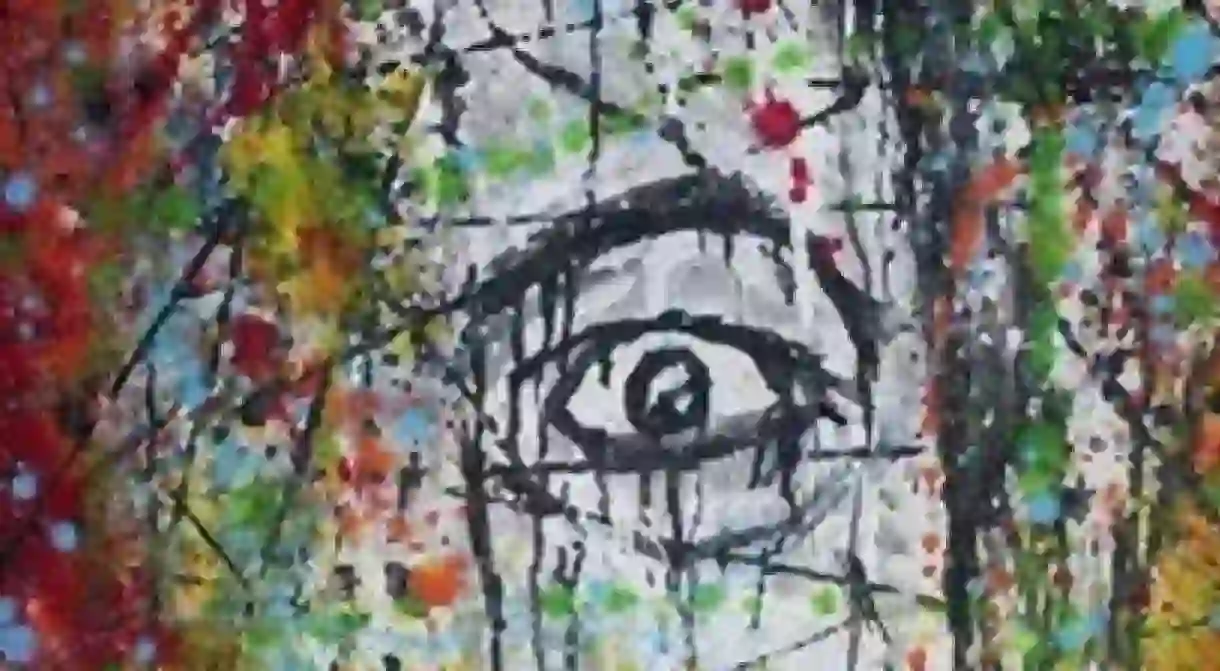Franck de las Mercedes: Born in Nicaragua/Made in the USA

Through the use of abstract expressionist language, photography and collage artist Franck de las Mercedes creates an indelible account of his emotive vision of the world. His recent project, The Priority Boxes, has cemented his reputation as one of the most creative Nicaraguan artists, putting the spotlight on Nicaragua’s burgeoning art and culture scene.

Born in Nicaragua and raised in New York City, Franck de Las Mercedes is highly recognised for his multi-faceted artistic output. His approach blends raw, expressionistic compositions, non-traditional handling of materials, and bursting colours that recall Nicaragua’s vibrancy and tropical exuberance. A self-taught artist, he divides his works into different categories: abstract, figurative, portraits, and particular series, such as his ongoing project The Priority Boxes. With this last project in particular, which begun in 2006, de Las Mercedes has garnered much attention from the media and public, as it directs attention to issues such as peace, justice, love, and the possibility of effecting change on a community.
Anyone who requests a ‘Priority Box’ receives a painted box that reads ‘Fragile: Contains Peace’. The artist involves several parties with a single artwork through his rapport with the person who requests the box, the person who works at the post office, the carriers, and anyone else who has a chance to look at or interact with the box. In the end the project is not only about reflection on our environment and the different ways a work of art can involve the public; it also attempts to establish a dialogue of co-existence between the different inhabitants of the planet. So far de Las Mercedes has shipped over 8,000 boxes around the globe.

His pictorial output is also equally ambitious and prolific, and for this reason de Las Mercedes has categorised his work into both series and styles. In his ‘Portraits’ for instance, we find a plethora of real and imaginary characters, from Salvador Dalí to Alice (from the Lewis Carroll story Alice in Wonderland). His painting Dalismático (Half-of a Dalí) (2010) shows us a half-hidden face of the Spanish maestro of surrealism. His signature stiletto mustache is a dead give-away, obscured – or perhaps revealed – by layers of splattered and spilt acrylic paint.
The title of the painting is a play on the Spanish word carismático, or charismatic, an adjective that was perhaps used as a euphemism to describe Dalí’s outrageous and eccentric personality. Franck de Las Mercedes chooses to do away with this word and instead invents his own adjective – ‘Dalismatic’– perhaps more fitting to the visionary, egotistic painter. Apart from paying homage to one of his influences, de Las Mercedes juxtaposes abstract-expressionist pictorial language with the archetypal surrealist painter’s portrait. This juxtaposition likely highlights Dalí’s claim that his technique was as refined as Raphael’s, the legendary Italian Renaissance painter. In contrast, de Las Mercedes’ brush is a broadsword, leaving slashes of paint and splashed color to form the mauled texture of the painted surface. Thereby de Las Mercedes separates himself from the surrealist Spaniard while at the same time identifying him as one of his major influences.

Though always a prolific modulator of abstraction, de Las Mercedes has kept an affinity for more traditional pictorial approaches such as portraiture. In his series, A Quiet Riot, the artist nostalgically pays tribute to several musical legends. He focuses on portraying Hispanic-American musicians that have been transcendental to the history of popular Western music, especially hard rock and heavy metal. In Max Cavalera (2011), de Las Mercedes renders a monochrome portrait of the front man of Brazilian death metal band Sepultura. Cavalera enjoys near mythical status among fans of hard rock and heavy metal and is generally recognised as one of the most influential musicians of the 1990s. Embracing a black and white palette, de Las Mercedes renders the likeness of the musician yet encapsulates the portrait in a barrage of paint, which could be read as visual noise. True to his Latino roots, this series takes its name from the group Quiet Riot which counted among its former members guitarist Carlos Cavazo of Mexican origin, also represented in this series. As a Latino-American, de Las Mercedes wants to connect to other aspects of his identity through his artwork. This series belies an almost naïve sense of belonging.

His abstract work is completely effusive and unapologetic and has the feeling of shifting through several decades of pictorial abstraction. One of his most salient gestures is the drip, a visual slash of paint that cuts across the surface in several directions. The spill, and the particular movement of paint across the surface, also bring forth connections to the abstract expressionist tradition. One important aspect present in de Las Mercedes’ work is the idea of the canvas as an arena – a place where emotions, memory, and psyche all wrestle for attention and space. In Existential Angst (2012), several garish colours battle each other in a chaotic composition that is only ordered by the fact that the canvas has a finite length. As its title suggests, it is a heavy concept that the artist aims to depict. The viewer can readily identify spills, slashes of colour, violent brushstrokes and scratches as gestures which form an image that brings both sound and fury to a disturbing psychological state.

De Las Mercedes’ figurative work is similarly raw and immediate. Through his art he attempts to represent and facilitate understanding of his environment, feelings, and experiences. In Así era mi Padre (This is how my Father was) (2011), de Las Mercedes brings a highly personal topic to his paintings. Here he depicts a monochromatic, semi-abstract figure with a blank face as his father. Another painting, The Pact (2011), shows two figures engaging in a mysterious transaction. There is something somber in these paintings, but there is also a sense of redemption, in de Las Mercedes’ attempt to reconcile with difficult subjects.













